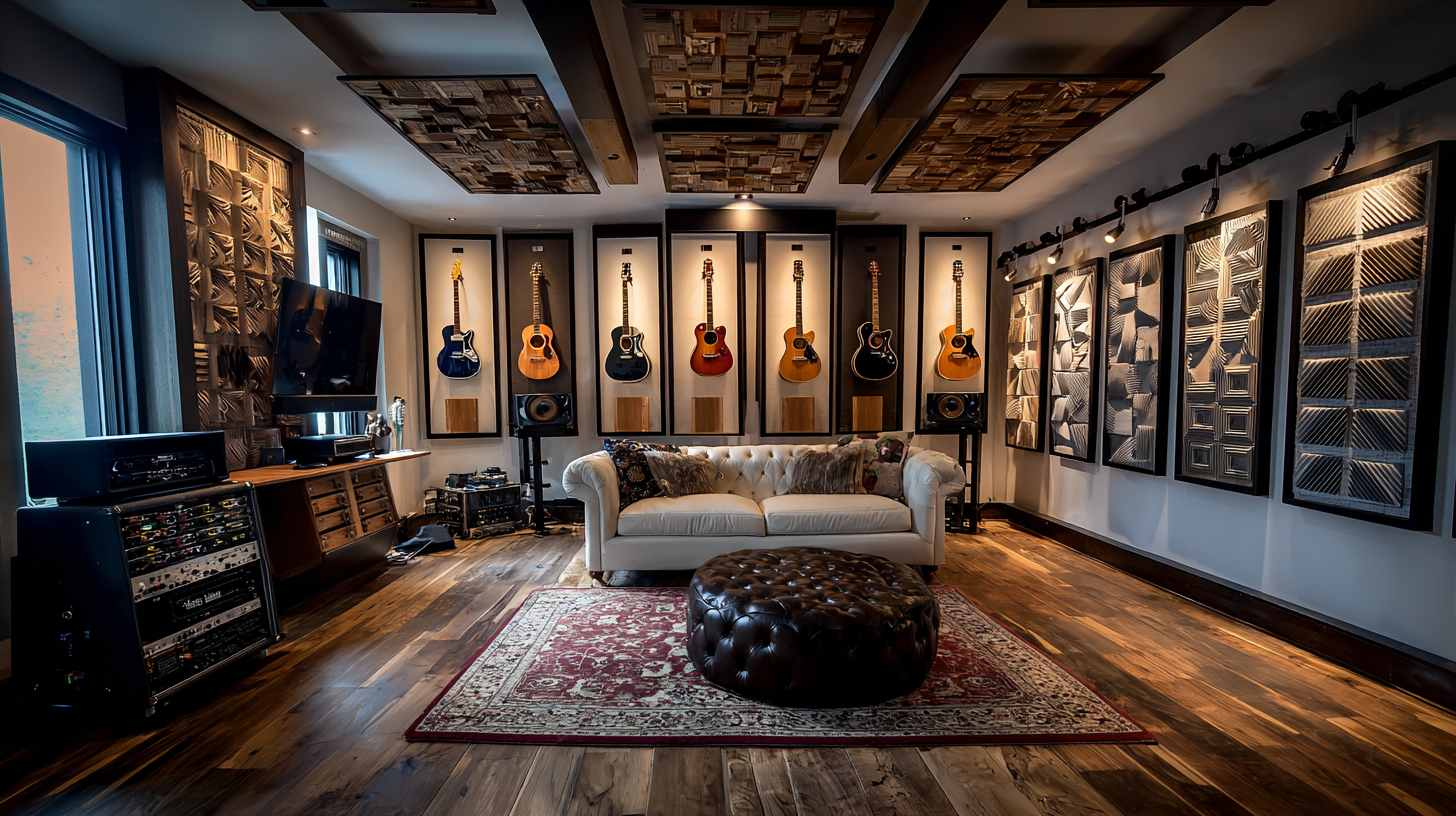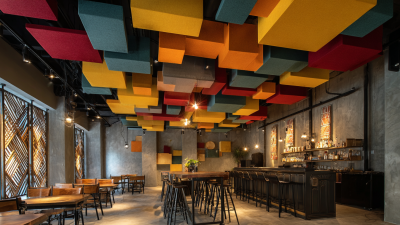In an era where sound quality can make or break a space, custom acoustic panels have emerged as an essential solution for enhancing auditory experiences in both commercial and residential environments. According to renowned acoustic expert Dr. Emily Parker, "Investing in high-quality custom acoustic panels not only improves sound clarity but also transforms the aesthetic appeal of any room." As we delve into the top 10 custom acoustic panels for superior sound quality in your space, it’s vital to understand the impact these products can have on your acoustic environment.

Custom acoustic panels are not just functional; they represent a harmonious blend of creativity and technology. Designed to absorb sound waves, these panels minimize reverberation and unwanted noise, enabling an immersive auditory experience. Travelers, musicians, and even home-theater enthusiasts recognize that the right acoustic solution can elevate their engagement, ensuring clarity and depth in every sound interaction.
Join us as we explore the leading options available in 2025, ensuring you find the perfect custom acoustic panels tailored to your needs while transforming your space into an acoustically optimized haven.
When it comes to enhancing sound quality in any space, custom acoustic panels are an essential investment for achieving optimal sound clarity. These panels not only help reduce echoes and reverberations but also improve the overall listening experience. By selectively absorbing and diffusing sound waves, they create a balanced auditory environment suitable for everything from home theaters to recording studios.

When choosing custom acoustic panels, consider the material and thickness. Different materials, such as foam or fabric-wrapped panels, offer varying degrees of absorption. For best results, opt for thicker panels in larger spaces to capture lower frequencies while maintaining clarity across higher tones. Additionally, strategically placing panels at first reflection points can significantly enhance sound clarity, ensuring that sound travels smoothly without interference.
Tips for maximizing the efficiency of your acoustic panels include using a combination of various panel types and shapes. Mixing diffusers with absorptive panels can create a more dynamic and controlled soundscape. Furthermore, experimenting with the layout will help you find the optimal arrangement to suit your unique space, allowing sound to flow naturally and effortlessly.
When selecting custom acoustic panels, understanding the key factors that influence their performance and material choice can greatly enhance sound quality in your space. The first critical factor is the type of material used in the panels. Materials like foam, fabric, and wood have differing sound absorption properties. For instance, foam panels are effective at reducing high-frequency noise, while dense materials like wood can offer a more balanced acoustic response through diffusion and absorption.
Another significant aspect is panel thickness and density. Thicker panels generally provide better sound absorption, particularly for lower frequencies. Yet, it’s essential to strike a balance, as overly thick panels may not fit well within the aesthetic or spatial constraints of your room. Additionally, the panel placement plays a crucial role in optimizing performance. Strategic positioning—such as corner placement for bass traps—can effectively mitigate undesirable echoes and refine overall audio clarity, ensuring an immersive auditory experience tailored to your specific environment.
| Panel Type | Material | Thickness (inches) | NRC Rating | Dimensions (inches) |
|---|---|---|---|---|
| Panel A | Fiberglass | 2 | 0.95 | 24 x 48 |
| Panel B | Polyester | 1.5 | 0.85 | 24 x 24 |
| Panel C | Wood Fiber | 3 | 0.90 | 48 x 48 |
| Panel D | Mineral Wool | 2 | 1.00 | 24 x 48 |
| Panel E | Acoustic Foam | 1 | 0.80 | 12 x 12 |
| Panel F | Fabric-Wrapped | 2.5 | 0.95 | 36 x 36 |
| Panel G | Recycled Plastic | 2 | 0.88 | 48 x 24 |
| Panel H | Cork | 1.5 | 0.77 | 36 x 36 |
| Panel I | Perforated Wood | 1 | 0.83 | 48 x 24 |
| Panel J | Glass Wool | 2 | 0.95 | 24 x 48 |
When selecting custom acoustic panels for your space, understanding their sound absorption ratings is crucial. Two key metrics to consider are the Noise Reduction Coefficient (NRC) and the Sound Absorption Average (SAA). The NRC measures the average sound absorption across various frequencies, giving you a quick understanding of how effective a panel is in dampening sound. For instance, panels with an NRC of 0.70 can absorb up to 70% of sound energy, making them ideal for spaces such as recording studios or home theaters.
On the other hand, the SAA provides a more comprehensive assessment of a panel's sound absorption abilities by averaging the absorption coefficients for frequencies within the range of 200 to 2500 Hz. Panels with an SAA value approaching 1.00 are excellent at reducing noise levels. According to a 2021 report by the Acoustical Society of America, selecting panels with an NRC of at least 0.85 or an SAA of 0.90 can significantly enhance sound quality in acoustic-sensitive environments. Therefore, when choosing acoustic panels, always review these specifications to ensure you are investing in solutions that meet your soundproofing needs effectively.

In the realm of custom acoustic panels, design and functionality coexist harmoniously. Recent discussions highlight that incorporating personalized acoustic solutions not only enhances sound quality but also elevates interior aesthetics. A study indicated that spaces with well-integrated acoustic treatments improve sound clarity by up to 50%, significantly impacting the listening experience. This transformative approach to design aligns with current trends where aesthetic appeal is paramount, especially in modern living spaces.
Custom acoustic panels can seamlessly blend with décor, serving as both artistic elements and sound control solutions. For instance, research demonstrates that homeowners prioritize both beauty and functionality, with 67% expressing that aesthetics are just as important as performance when choosing sound solutions. Furthermore, smart design choices are resonating within the growing prefab living sector, where manufactured homes are recognized for their ability to combine practicality with visual appeal. By leveraging cutting-edge materials and innovative design techniques, custom acoustic panels are instrumental in creating environments that not only sound incredible but also look stunning, fulfilling the dual demands of contemporary design.
The effectiveness of sound insulation in custom acoustic panels largely hinges on two critical factors: thickness and density. Thicker panels generally offer better sound absorption capabilities, which is essential for preventing sound waves from bouncing around and creating unwanted echoes. As the thickness increases, the panels can trap more sound energy, thus enhancing overall acoustic performance in a given space. For instance, panels with a thickness of at least two inches are often favored in recording studios or home theaters, where superior sound quality is crucial.
Density, on the other hand, also plays a pivotal role in sound insulation. High-density materials tend to absorb more sound frequencies, especially lower ones, which can be challenging for thinner and less dense panels. This is particularly important in environments where bass-heavy sounds are prevalent, such as music venues or bass guitar practice rooms. Therefore, selecting custom acoustic panels that combine both optimal thickness and material density will significantly enhance sound quality, creating spaces that are acoustically balanced and free from disturbances.
The chart above illustrates the sound insulation effectiveness of the top 10 custom acoustic panels measured by their Noise Reduction Coefficient (NRC) rating. A higher NRC rating indicates better sound absorption properties, making it crucial for enhancing sound quality in any space.






